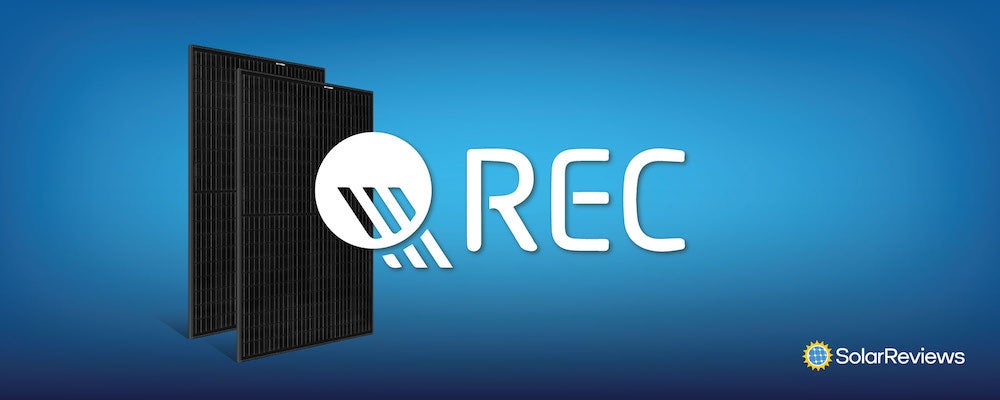
REC Group is a solar panel manufacturer based in Norway, and since its founding in 1996, it has manufactured 38 million solar panels, generated 10 gigawatts of solar energy, and provided 16+ million people with solar power. REC has a presence in the United States, Europe, and Asia, with its panel manufacturing primarily in Singapore.
REC offers high-quality photovoltaic solar panel models that landed them a spot on SolarReviews’ Best Solar Panel Manufacturer list, but are they right for your home? We review the top models, features that they offer, and their unique half-cut cell technology.
Why you can trust SolarReviews:
SolarReviews is the leading American website for consumer reviews and ratings of residential solar panels and solar panel installation companies. Our industry experts have over two decades of solar experience combined and maintain editorial independence for their reviews. No company can pay to alter the reviews or review scores shown on our site. Learn more about SolarReviews and how we make money.Key takeaways
- REC pioneered half-cut cell technology, which improves efficiency and wattage of the solar panel.
- All of the REC panels are of top quality and come with a competitive 25-year product warranty if installed by an REC-certified installer.
- REC solar panels are built to be high quality but sell for a competitive price, you can expect to pay the national average cost per watt for your REC solar panel system.
- REC was awarded 4th place in SolarReviews’ ranking of the top 10 solar panel manufacturers of 2023.
What is REC half-cut cell technology?
One of the things that makes REC solar panels stand out is their award-winning half-cut cell technology.
REC pioneered the design in 2014, which increases the energy output of solar panels by reducing the size of solar cells so that more can fit on the panel. Then, the panel is split in half so that the top and bottom half operate as two separate panels, generating energy even if one half is shaded.
REC’s half-cut cell technology. Image source: REC Group
This half-cut cell technology has allowed REC to produce solar panels with extremely high wattage and a higher efficiency than average, giving you more solar power per square foot.
We will get into more detail about how the half-cut cell technology sets REC apart in the model descriptions below.
What are the top REC solar panel models?
Check out the below video, where SolarReviews founder Andy Sendy breaks down the key information you need to know about REC solar panels.
REC prides itself on rigorous testing of their PV modules, as well as a 25-year warranty for products and labor on small-scale solar energy system installations (as long as the installations are completed by an REC-certified technician).
The following are REC’s top-rated solar panel models:
REC Alpha Series
REC Alpha solar panel. Image source: REC Group
The REC Alpha Series is the newest addition to their model lineup and is one of their best-performing panels. They have advanced cell technology with increased wiring to improve the flow of the electrical current - one of the top features of half-cut cell technology.
Other key features include:
- 380-watt power, delivering 20% more electricity than conventional solar panels, which is typically 320 watts, on the high end
- The REC Alpha Series has heterojunction cell technology (HJT), which offers high energy coefficients and less power loss. This is what gives the Alpha its extremely impressive 380 watts of power
- A 25-year product warranty, including a guarantee of 92% power output after 25 years
REC N-Peak Series
REC N-Peak solar panel. Image source: REC Group
The REC N-Peak Series is built for high efficiency and high power output for maximum use in small locations.
The N-Peak Series also uses the half-cut cell technology that was pioneered by REC and is a premium, n-type monocrystalline solar panel. As an n-type solar system, REC panels are not susceptible to “light-induced degradation”, which is caused by a chemical reaction within the panel. This means more power for you.
The N-Peak Series has two model types, the REC N-Peak Series and the REC N-Peak Black Series, ranging in 310-330 watts. The Black Series offers a sleeker look with a black backsheet and black frame, making the entire panel look cohesive.
- The N-Peak Series includes extra support bars that provide more durability
- The N- Peak Series has a 20-year product warranty and a 25-year power output warranty which accounts for a 0.5% annual degradation. This means your panels are guaranteed to produce 86% of their original power on their 25th year
REC TwinPeak 2 Series
REC TwinPeak 2 Mono solar panel, REC TwinPeak 2 solar panel. Image source: REC Group
Based on the REC TwinPeak technology, the TwinPeak 2 offers a higher power output per square foot versus the original TwinPeak design. The TwinPeak 2 design allows both sides of the panel to operate as two separate panels and they are split in the middle with separate wiring powering each side of the panel. This means that if one half is shaded, the other can still generate power.
- The TwinPeak 2 Mono panel ranges from 300 to 330 watts of power and comes in a standard design
- The less efficient, yet still high-performing REC Twinpeak 2 Series, or Blk2 for short, is different from the TwinPeak 2 Mono because it is a polycrystalline option instead of monocrystalline
- Both the TwinPeak 2 and TwinPeak 2 Mono panels have a 20-year product warranty and a 25-year power output warranty. You can get an additional 5 years on the product warranty by using REC-certified solar installers
How does REC compare to other solar panel manufacturers?
To determine true value when comparing solar modules, it is important to consider efficiency, performance, warranties, and the cost of the panels.
REC solar panel efficiency
Solar panel efficiency is the percentage of energy the solar panels can absorb from the sun and turn into usable electricity. The industry average is between 15%-20%, meaning 15%-20% of the sun’s energy is converted to electricity.
REC solar panels range in efficiency from about 17%-20% which puts them on the high end in terms of efficiency.
REC solar panel performance
The performance of solar panels is one of the most important considerations, there is no point in putting less efficient solar panels on your roof if they will not generate the electricity you need. Aside from efficiency, the temperature coefficient is an important factor in determining their performance, as well.
The temperature coefficient is measured by how much the performance of the panels decreases by each increasing degree in temperature. Your solar panels can be hotter than the temperature outside because as a black surface, they absorb more heat. The hotter it gets, the more challenging it is for solar panels to produce power.
Solar panels are made to withstand extreme heat and weather conditions. They are tested and designed to handle 25 degrees Celsius, or 77 degrees Fahrenheit. Their performance slightly decreases with the increase in temperature of any degree above 77 degrees Fahrenheit. Most solar panels have a temperature coefficient of .3%-.5%, so for each increase in temperature, the performance decreases by .3%-.5%.
The REC N-Peak Series has a temperature coefficient of -.35%, putting it right in the middle of the temperature coefficient range, which means that even on really hot days, your solar panels will perform just fine.
REC solar panel warranties
For any large purchase, warranties are extremely important to make sure you are covered in the event of system failure.
Most high-end solar panel companies offer a 25-year warranty for the product quality and power output. However, for some REC panels like the TwinPeak Mono, the warranty is only 20 years. It can be 25 years only if an REC-certified installer installs the panels.
REC does have competitive warranties, but just make sure your solar installer is REC-certified so that you can take advantage of all of the benefits available to you.
REC solar panel cost
Like any solar panel that needs to be installed by a professional, the price does vary state to state and even by different solar companies based on installation costs. By working with a reputable solar installer, you can get the best price in your area for REC panels by utilizing local incentives and the 30% federal tax credit.
You can expect REC panels to cost between $2.40-$3.60 per watt, making them within a reasonable price range, considering the U.S. average cost per watt is $3.00 as of December 2022.
Should you buy REC solar panels?
REC solar panels are an excellent choice. If you are looking for a panel that is built with quality in mind that will power your home for years to come, REC panels will deliver.
Being a well-established company is another reason to choose REC, since you can count on them to provide customer service should you ever need to rely on the panel warranty.
Because you cannot buy REC solar panels for a DIY project, you need to work with a solar company to install these particular panels. Homeowners can work with a solar installer to help determine if they are the cheapest option in terms of cost per watt for a solar installation.
